SEIZURE DISORDERS IN DOGS AND CATS
by R.M. Clemmons, DVM, PhD
Associate Professor of Neurology & Neurosurgery
Introduction:
Seizure disorders make up a significant proportion of referrals to veterinary
neurologists. While the number of cats with seizures is less, it is estimated
that 1% of the canine population has some form of seizure disorder. Due
to the presence of idiopathic (inherited) epilepsy in certain breeds of
dogs, the incidence can be as high as 15 to 20% in those breeds. As such,
seizure diagnosis and treatment is an important aspect of veterinary neurology.
Any reproducible change in behavior, usually associated with altered
consciousness and increased voluntary or involuntary motor tone, can be
a seizure. Generally, the seizure represents a paroxysmal, uncontrolled,
transient electric discharge from the neurons in the brain. Anatomically,
seizures can develop from conditions affecting the forebrain, cranial to
the mesencephalon. The presence of a seizure disorder, then, localizes
(at least part of) the disease process in the cerebral cortex, thalamus,
hypothalamus or mesencephalon. A typical seizure is characterized by a
prodromal period (when the animal may recognize that a seizure event is
coming and react in a characteristic manner), the ictus (the actual seizure
event), the post-ictal phase (which may include pacing, eating or sleeping,
but which is characteristic for that patient), and the inter-ictal phase
(the period between seizures, where the animal may appear normal). During
the seizure (ictus), there is usually a decrease in consciousness followed
by increased motor tone including alternative tonic and clonic activity.
In addition, autonomic tone increases which can lead to salivation, defecation
and urination.
 Seizure disorders
can be differentiated into epilepsy or active seizure disease. Epilepsy
can be inherited (idiopathic) or acquired. As such, epilepsy can be defined
as a seizure disorder characterized by an inborn biochemical defect of
neurons or by the presence of an old injury, both of which lead to abnormal
electrical activity in the brain. The former defines idiopathic epilepsy,
while the latter defines acquired epilepsy. In general, epilepsy represents
a seizure disorder where the seizure is the disease and treating the seizure
treats the disease. On the other hand, active seizure disease is defined
as a seizure disorder where the seizure represents only one symptom or
manifestation of the true disease process. In this case treating the seizure
only treats the symptom, not the disease. The goal of neurologic assessment
of patients with seizures is to determine whether the problem is due to
epilepsy or secondary to an active seizure disease. The latter condition
requires the greatest effort to diagnose and treat, since the active cause
must be found and eliminated in order to control the brain abnormality.
Failure to do so will eventually result in failure of seizure control.
On the other hand, in treating epilepsy, the effort can be concentrated
upon controlling the seizure.
Seizure disorders
can be differentiated into epilepsy or active seizure disease. Epilepsy
can be inherited (idiopathic) or acquired. As such, epilepsy can be defined
as a seizure disorder characterized by an inborn biochemical defect of
neurons or by the presence of an old injury, both of which lead to abnormal
electrical activity in the brain. The former defines idiopathic epilepsy,
while the latter defines acquired epilepsy. In general, epilepsy represents
a seizure disorder where the seizure is the disease and treating the seizure
treats the disease. On the other hand, active seizure disease is defined
as a seizure disorder where the seizure represents only one symptom or
manifestation of the true disease process. In this case treating the seizure
only treats the symptom, not the disease. The goal of neurologic assessment
of patients with seizures is to determine whether the problem is due to
epilepsy or secondary to an active seizure disease. The latter condition
requires the greatest effort to diagnose and treat, since the active cause
must be found and eliminated in order to control the brain abnormality.
Failure to do so will eventually result in failure of seizure control.
On the other hand, in treating epilepsy, the effort can be concentrated
upon controlling the seizure.
Classification of Seizures:
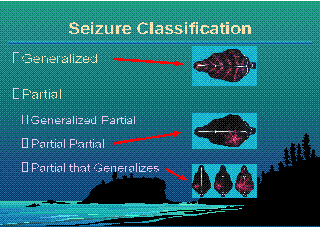 Seizures can
be separated into generalized seizures and partial seizures. This distinction
is based upon whether the patient loses consciousness or not. Partial seizures
can further be divided into generalized-partial seizures (a unique idiopathic
epilepsy seen in certain breeds of dogs), partial-partial seizures, and
partial seizures which generalize. Generalized seizures can be idiopathic
epilepsy, acquired epilepsy or active seizure disease. On the other hand,
partial-partial seizures or partial seizures which generalize can not be
idiopathic epilepsy. Generalized-partial seizures are only seen as a form
of idiopathic epilepsy in dachshunds and poodles. Therefore, while the
classification of the seizure may not specify the nature of the seizure
disorder, it can help narrow the possibilities. Symmetry of the seizure
is important, too. Idiopathic epilepsy is always symmetrical, whether generalized
or partial. An asymmetric seizure cannot be idiopathic epilepsy.
Seizures can
be separated into generalized seizures and partial seizures. This distinction
is based upon whether the patient loses consciousness or not. Partial seizures
can further be divided into generalized-partial seizures (a unique idiopathic
epilepsy seen in certain breeds of dogs), partial-partial seizures, and
partial seizures which generalize. Generalized seizures can be idiopathic
epilepsy, acquired epilepsy or active seizure disease. On the other hand,
partial-partial seizures or partial seizures which generalize can not be
idiopathic epilepsy. Generalized-partial seizures are only seen as a form
of idiopathic epilepsy in dachshunds and poodles. Therefore, while the
classification of the seizure may not specify the nature of the seizure
disorder, it can help narrow the possibilities. Symmetry of the seizure
is important, too. Idiopathic epilepsy is always symmetrical, whether generalized
or partial. An asymmetric seizure cannot be idiopathic epilepsy.
Seizure Diagnosis:
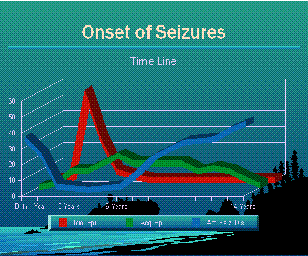 Signalment.
The age of the patient is important in assessing the likelihood of the
nature of the seizure disorder. Idiopathic epilepsy, in general, has its
age of onset between 1 and 3 years of age. In addition, idiopathic epilepsy
is most common in purebred dogs and cats. While acquired epilepsy can occur
at any age, it usually follows the inciting injury by 6 months to 1 year.
As such, acquired epilepsy does not usually begin before the age of 1 year.
Since active seizure disease represents concurrent systemic disease, it
will occur with greatest frequency at times when animals are most susceptible
to disease. These periods are at the extremes of life, when the immune
system is less active. As such, active seizure diseases are most common
before 1 year of age and after 6 years of age.
Signalment.
The age of the patient is important in assessing the likelihood of the
nature of the seizure disorder. Idiopathic epilepsy, in general, has its
age of onset between 1 and 3 years of age. In addition, idiopathic epilepsy
is most common in purebred dogs and cats. While acquired epilepsy can occur
at any age, it usually follows the inciting injury by 6 months to 1 year.
As such, acquired epilepsy does not usually begin before the age of 1 year.
Since active seizure disease represents concurrent systemic disease, it
will occur with greatest frequency at times when animals are most susceptible
to disease. These periods are at the extremes of life, when the immune
system is less active. As such, active seizure diseases are most common
before 1 year of age and after 6 years of age.
Minimum Data Base. The minimum data base for seizures is a physical,
neurologic and fundoscopic examinations. Initial clinicopathologic examinations
include a CBC, Chemistry Profile plus serum cholinesterase and serum bile
acid concentrations, and a urinalysis. In some patients, heartworm and
internal parasite examinations are needed. Chest and abdominal radiographs
are indicated in animals with abnormal physical findings and in patients
over 6 years of age. If these tests are normal, a decision to perform ancillary
diagnostic test must be made. For seizure evaluation, these include CSF
tap and analysis, EEG and MRI examinations.
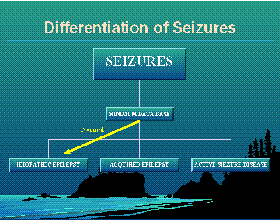
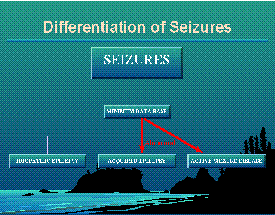 In idiopathic epilepsy, all of the test results return as normal, since
this is an inborn biochemical defect which does not cause abnormalities
except during the seizure. In an otherwise healthy purebred dogs between
1 and 3 years of age which have a generalized seizure disorder (or generalized-partial
seizure disorder) and no neurologic deficits on examination, the tentative
diagnosis of idiopathic epilepsy should be made. The patient should continue
to be normal on subsequent examinations. Assuming the patient lives to
be an old patient without evidence of neurologic deficits, then the diagnosis
was probably correct. In the past, many breeders wished to determine whether
the animals had inherited epilepsy. However, epilepsy appears to involve
6 gene pairs, which make the genetics of epilepsy more complicated than
hip dysplasia. As such, I feel it is a disease which we must learn to live
with, and treat where appropriate. If a breeder gets an incidence of epilepsy
greater than 6%, they are making poor choices. Colony-bred beagles have
an incidence of 5.9%, based upon their own breeding decisions.
In idiopathic epilepsy, all of the test results return as normal, since
this is an inborn biochemical defect which does not cause abnormalities
except during the seizure. In an otherwise healthy purebred dogs between
1 and 3 years of age which have a generalized seizure disorder (or generalized-partial
seizure disorder) and no neurologic deficits on examination, the tentative
diagnosis of idiopathic epilepsy should be made. The patient should continue
to be normal on subsequent examinations. Assuming the patient lives to
be an old patient without evidence of neurologic deficits, then the diagnosis
was probably correct. In the past, many breeders wished to determine whether
the animals had inherited epilepsy. However, epilepsy appears to involve
6 gene pairs, which make the genetics of epilepsy more complicated than
hip dysplasia. As such, I feel it is a disease which we must learn to live
with, and treat where appropriate. If a breeder gets an incidence of epilepsy
greater than 6%, they are making poor choices. Colony-bred beagles have
an incidence of 5.9%, based upon their own breeding decisions.
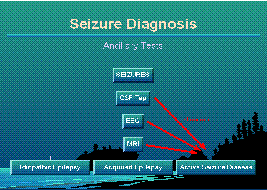
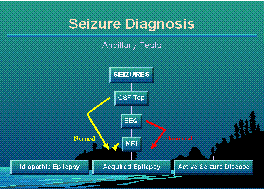 In both acquired epilepsy and active seizure disease, the neurologic examination
will often be abnormal (which distinguish these conditions from idiopathic
epilepsy). Often with active seizure disease, the minimum data base will
demonstrate the underlying disease process. The minimum data base is normal
in acquired epilepsy. However, since certain active seizure diseases are
restricted to the CNS, further diagnostic tests are needed to separate
these two conditions. The EEG will be abnormal in each, which does not
help differentiate the problems, although the EEG will often be more abnormal
in active seizure disease. The single most important test is the CSF tap
and analysis. Since the injury which results in acquired epilepsy is long
healed, the CSF will be normal in that condition. On the other hand, the
CSF is usually abnormal in active seizure disease. Finally, MRI can help
identify those conditions which do not markedly alter the CSF, yet cause
an active seizure disease. The MRI remains normal in acquired epilepsy.
In both acquired epilepsy and active seizure disease, the neurologic examination
will often be abnormal (which distinguish these conditions from idiopathic
epilepsy). Often with active seizure disease, the minimum data base will
demonstrate the underlying disease process. The minimum data base is normal
in acquired epilepsy. However, since certain active seizure diseases are
restricted to the CNS, further diagnostic tests are needed to separate
these two conditions. The EEG will be abnormal in each, which does not
help differentiate the problems, although the EEG will often be more abnormal
in active seizure disease. The single most important test is the CSF tap
and analysis. Since the injury which results in acquired epilepsy is long
healed, the CSF will be normal in that condition. On the other hand, the
CSF is usually abnormal in active seizure disease. Finally, MRI can help
identify those conditions which do not markedly alter the CSF, yet cause
an active seizure disease. The MRI remains normal in acquired epilepsy.
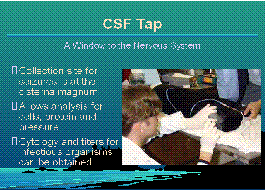
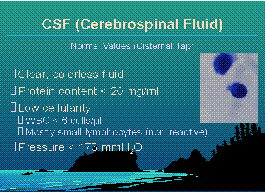



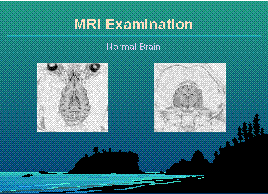
Seizure Treatment:
When treating active seizure disease, it is necessary to treat the primary
disease. If this is successful, the seizure disorder may disappear and
no longer need treatment. However, once anti-convulsant medications are
started, they should be continued for a minimum of 6 months. If the primary
disease is under control and there has been no evidence of continued seizures,
the anti-convulsant medications can be withdrawn slowly over 1-2 months.
Most of this discussion will focus on the treatment of epilepsy, a disease
which is treated by the use of anticonvulsants. The principles of treating
the seizures of active seizure disease are consistent with this discussion
with the recognition of the above mentioned conditions.
The treatment of epilepsy is limited in dogs and cats due to the relatively
few anticonvulsants which have been shown to be effective. In addition,
dogs and cats do not develop ketoacidosis on high fat diets, so dietary
measures which are effective in human beings are ineffective in animals.
Some of the newer anticonvulsants in human beings have toxic side-effects
in dogs or cats or do not appear to be effective in controlling seizures
in animals.
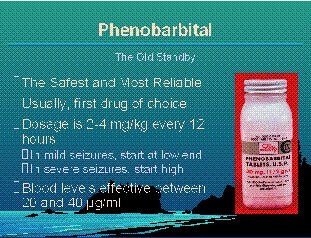 Phenobarbital.
Of the available anticonvulsants, the cheapest and most effective in animals
is phenobarbital. The dosage in dogs and cats is between 2-4 mg/kg every
12 hours. When treating seizures, it is my experience that it is better
to start higher and later reduce the dosage then to use too little, always
trying to catch up with the seizure disorder. The goal is to achieve a
steady blood level between 20-40 µg/ml. While these values vary slightly
between laboratories, most of the methodology to determine serum phenobarbital
concentrations is standardized. If you are worried about toxicity, measure
the peak concentration by pulling the sample 2 hours after the last dose.
If worried about having enough drug to be effective, measure the minimal
level by taking the sample just before the last dose. If cost is not a
factor, measure both and adjust the dosage accordingly. If the peak is
high and the valley low, then add a third dose in between. In dogs, unlike
human beings, 60% of phenobarbital is bound to plasma proteins and 10%
is displacable from the binding sites. As such, phenobarbital concentrations
may need adjustment if given with drugs which are known to displace plasma
binding, like sulfa drugs.
Phenobarbital.
Of the available anticonvulsants, the cheapest and most effective in animals
is phenobarbital. The dosage in dogs and cats is between 2-4 mg/kg every
12 hours. When treating seizures, it is my experience that it is better
to start higher and later reduce the dosage then to use too little, always
trying to catch up with the seizure disorder. The goal is to achieve a
steady blood level between 20-40 µg/ml. While these values vary slightly
between laboratories, most of the methodology to determine serum phenobarbital
concentrations is standardized. If you are worried about toxicity, measure
the peak concentration by pulling the sample 2 hours after the last dose.
If worried about having enough drug to be effective, measure the minimal
level by taking the sample just before the last dose. If cost is not a
factor, measure both and adjust the dosage accordingly. If the peak is
high and the valley low, then add a third dose in between. In dogs, unlike
human beings, 60% of phenobarbital is bound to plasma proteins and 10%
is displacable from the binding sites. As such, phenobarbital concentrations
may need adjustment if given with drugs which are known to displace plasma
binding, like sulfa drugs.
Phenobarbital is immediately effective, although it takes 3-5 days to
reach a stable plasma concentration. During initial medication, phenobarbital
will induce hemodilution, due to a steroid-like effect. In addition, many
patients experience sedation which will usually diminish within 2 weeks.
If the sedation is too severe, the dosage may need to be reduced until
the patient develops tolerance to the medication. It is thought that phenobarbital
acts through increasing the activity of GABA neurons, the inhibitory neurotransmitter
in the CNS. Most neurologists feel that 80% of all seizure disorders can
be controlled by phenobarbital, alone.
Phenobarbital generally is safe and well tolerated. It does, however,
induce hepatocholestasis and a dose-dependent liver disfunction. In some
cases, this can be a significant problem and require reduction or elimination
of the drug. Most of the time, this liver disfunction will correct upon
reduction of phenobarbital. On the other hand, another drug (which I will
not speak of here), primidone, can cause a dose-dependent, irreversible
liver failure.
KBr. Potassium bromide (KBr) is another effective anticonvulsant
which has been used in dogs and cats for the past 10 years. It is an old
compound and has only recently been re-discovered as an effective drug.
KBr is usually used as an adjunct to phenobarbital therapy. It is believed
that KBr will help control 75% of the patients who cannot be controlled
with phenobarbital alone. When used with phenobarbital, KBr is dosed once
a day at 33 mg/kg. Usually, it is given at night. Since it is not a pharmaceutical,
it must be made from chemical grade KBr by a compounding pharmacist. While
some people prefer capsules, I find that the liquid formulation works better.
It is made as a 250 mg/ml solution and given with food. It has a salty
taste which may not be palatable to some patients.
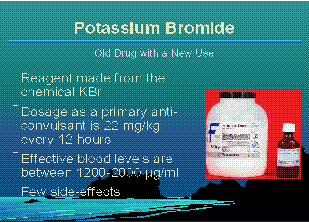 KBr can be added
to patients using phenobarbital who have liver disfunction (since KBr does
not have any known liver toxicity). In this case, the dosage of phenobarbital
should be reduced by 50% after the second KBr administration. If this is
still effective toward controlling the seizure, the phenobarbital dose
can be cut by an additional 50% each month until the dose of phenobarbital
is 1/8th of the initial dosage. At this time, I would not go lower. In
addition, the serum concentrations of phenobarbital will no longer be of
any clinical relevance. Hopefully, this will correct the liver function
tests.
KBr can be added
to patients using phenobarbital who have liver disfunction (since KBr does
not have any known liver toxicity). In this case, the dosage of phenobarbital
should be reduced by 50% after the second KBr administration. If this is
still effective toward controlling the seizure, the phenobarbital dose
can be cut by an additional 50% each month until the dose of phenobarbital
is 1/8th of the initial dosage. At this time, I would not go lower. In
addition, the serum concentrations of phenobarbital will no longer be of
any clinical relevance. Hopefully, this will correct the liver function
tests.
In some cases, KBr may need to be used as the sole anticonvulsant. In
that case, the dosage is 22 mg/kg every 12 hours. Although the serum half-life
is around 27 days, twice a day dosing seems to be more effective when KBr
is used alone. Since KBr has a long half-life, blood levels don't reach
steady-state for several months. I usually check the level in 1 month,
but do not adjust the dosage until a repeat level in 2 months. The goal
is to have a serum level between 1200-2000 µg/ml, optimally around
1500 µg/ml. To request this, make sure you ask the laboratory for
a quantitative Br level. If the level exceeds 2000 µg/ml, toxicity
can develop. This may show up as an increase in the seizures.
It is thought that KBr works by stabilizing the chloride channel, much
like the way lithium stabilizes the sodium channels in manic depression.
Since the chloride channels are involved in maintaining the "seizure" threshold,
KBr appears to work by reducing the likelihood of seizures developing.
Diazepam. Diazepam is a short acting anticonvulsant in dogs and
should be limited to stopping a seizure in process. In the cat, however,
diazepam is an effective anticonvulsant and can be used as a primary anticonvulsant,
given once or twice a day. The usual dosage is between 1-1.5 mg/kg. Recently,
intra rectal diazepam has been suggested to help control animals with cluster
seizures, whereby the rectal administration might stop the subsequent seizure
and can be administered by the client.
General considerations. In general, patients with seizures should
be fed a balanced diet without extra supplementation. They should avoid
chemicals and drugs which could make them more susceptible to seizures.
Although clinical studies have not yet been conducted in this area, in
our clinical experience, Heartgard or Heartgard Plus, Program and Advantage
appear to lower the seizure threshold and make siezure disorders more difficult
to control. In addition, exposure to organophosphate insecticides should
be limited. Interceptor and Filaribits appear to be safe for seizuring
patients. Of the newer flea control products, Frontline (Top Spot) appears
to be safe for dogs with seizure disorders.
When to treat. There are 2 schools of thought. Some feel that
with each seizure, the pathway becomes more established and, therefore,
more likely to recur. These people feel that early intervention makes ultimate
control of seizures more likely. The other school of thought is that anticonvulsants
should not be used until the seizure frequency is often enough to determine
whether the anticonvulsant is working. Everyone agrees that they should
be begun in cases of severe seizures or when the pattern is of a cluster
pattern, when the animal has multiple seizures when they occur (even if
the inter-ictal period is long). Since cluster seizures are often severe
and eventually life-threatening (and the hardest to control), I usually
start with phenobarbital (2 mg/kg BID) and KBr (33 mg/kg SID) right off
the bat. Even so, adjustments up and other measures are often needed to
help these patients.
Alternatives. Sometimes conventional therapy fails. In these
cases, alternatives should be investigated. Acupuncture can be effective
in some of these cases, if performed by a qualified veterinary acupuncturist.
Valerian root, an old anticonvulsant, may work with KBr when phenobarbital
cannot be used. Milk thistle, a natural product, may help protect the liver
from toxic damage and has been used to protect the liver from the effects
of chemotherapy. It should be investigated as a liver protectant from phenobarbital
therapy.
Treatment of Status Epilepticus:
Status epilepticus is a special case where seizures occur one after
another without abatement. If these seizures are not stopped, the resultant
hypoxia may result in irreparable brain damage. The goal, then, is to stop
the seizures. This requires injectable medications: diazepam, pentobarbital
and phenobarbital. Although pentobarbital is not an anticonvulsant, it
can sedate the patient long enough for phenobarbital to work. Give diazepam
(to effect) at 0.5-1.5 mg/kg IV. If the seizures continue, repeat and give
both pentobarbital and phenobarbital at 2 mg/kg IV. Remember to check the
glucose level and give if low and consider calcium glucconate if the seizure
don't seem to be controlled. Once the seizures are under control, the patient
should be examined to determine the cause of the seizures and anticonvulsant
therapy with phenobarbital and/or KBr continued while achieving the diagnosis.
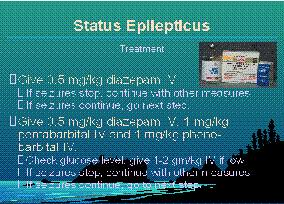
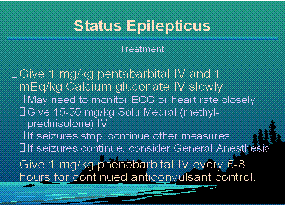
Coppyright Dog2Doc.com 1997
All Rights Reserved
 Hop Back to the Dog2Doc Home Page!!!
Hop Back to the Dog2Doc Home Page!!!
 View
Seizure PowerPoint Slides (frames) or non-framed
version.
View
Seizure PowerPoint Slides (frames) or non-framed
version.
Last updated 27 August 2002
 Seizure disorders
can be differentiated into epilepsy or active seizure disease. Epilepsy
can be inherited (idiopathic) or acquired. As such, epilepsy can be defined
as a seizure disorder characterized by an inborn biochemical defect of
neurons or by the presence of an old injury, both of which lead to abnormal
electrical activity in the brain. The former defines idiopathic epilepsy,
while the latter defines acquired epilepsy. In general, epilepsy represents
a seizure disorder where the seizure is the disease and treating the seizure
treats the disease. On the other hand, active seizure disease is defined
as a seizure disorder where the seizure represents only one symptom or
manifestation of the true disease process. In this case treating the seizure
only treats the symptom, not the disease. The goal of neurologic assessment
of patients with seizures is to determine whether the problem is due to
epilepsy or secondary to an active seizure disease. The latter condition
requires the greatest effort to diagnose and treat, since the active cause
must be found and eliminated in order to control the brain abnormality.
Failure to do so will eventually result in failure of seizure control.
On the other hand, in treating epilepsy, the effort can be concentrated
upon controlling the seizure.
Seizure disorders
can be differentiated into epilepsy or active seizure disease. Epilepsy
can be inherited (idiopathic) or acquired. As such, epilepsy can be defined
as a seizure disorder characterized by an inborn biochemical defect of
neurons or by the presence of an old injury, both of which lead to abnormal
electrical activity in the brain. The former defines idiopathic epilepsy,
while the latter defines acquired epilepsy. In general, epilepsy represents
a seizure disorder where the seizure is the disease and treating the seizure
treats the disease. On the other hand, active seizure disease is defined
as a seizure disorder where the seizure represents only one symptom or
manifestation of the true disease process. In this case treating the seizure
only treats the symptom, not the disease. The goal of neurologic assessment
of patients with seizures is to determine whether the problem is due to
epilepsy or secondary to an active seizure disease. The latter condition
requires the greatest effort to diagnose and treat, since the active cause
must be found and eliminated in order to control the brain abnormality.
Failure to do so will eventually result in failure of seizure control.
On the other hand, in treating epilepsy, the effort can be concentrated
upon controlling the seizure.
 Seizures can
be separated into generalized seizures and partial seizures. This distinction
is based upon whether the patient loses consciousness or not. Partial seizures
can further be divided into generalized-partial seizures (a unique idiopathic
epilepsy seen in certain breeds of dogs), partial-partial seizures, and
partial seizures which generalize. Generalized seizures can be idiopathic
epilepsy, acquired epilepsy or active seizure disease. On the other hand,
partial-partial seizures or partial seizures which generalize can not be
idiopathic epilepsy. Generalized-partial seizures are only seen as a form
of idiopathic epilepsy in dachshunds and poodles. Therefore, while the
classification of the seizure may not specify the nature of the seizure
disorder, it can help narrow the possibilities. Symmetry of the seizure
is important, too. Idiopathic epilepsy is always symmetrical, whether generalized
or partial. An asymmetric seizure cannot be idiopathic epilepsy.
Seizures can
be separated into generalized seizures and partial seizures. This distinction
is based upon whether the patient loses consciousness or not. Partial seizures
can further be divided into generalized-partial seizures (a unique idiopathic
epilepsy seen in certain breeds of dogs), partial-partial seizures, and
partial seizures which generalize. Generalized seizures can be idiopathic
epilepsy, acquired epilepsy or active seizure disease. On the other hand,
partial-partial seizures or partial seizures which generalize can not be
idiopathic epilepsy. Generalized-partial seizures are only seen as a form
of idiopathic epilepsy in dachshunds and poodles. Therefore, while the
classification of the seizure may not specify the nature of the seizure
disorder, it can help narrow the possibilities. Symmetry of the seizure
is important, too. Idiopathic epilepsy is always symmetrical, whether generalized
or partial. An asymmetric seizure cannot be idiopathic epilepsy.
 Signalment.
The age of the patient is important in assessing the likelihood of the
nature of the seizure disorder. Idiopathic epilepsy, in general, has its
age of onset between 1 and 3 years of age. In addition, idiopathic epilepsy
is most common in purebred dogs and cats. While acquired epilepsy can occur
at any age, it usually follows the inciting injury by 6 months to 1 year.
As such, acquired epilepsy does not usually begin before the age of 1 year.
Since active seizure disease represents concurrent systemic disease, it
will occur with greatest frequency at times when animals are most susceptible
to disease. These periods are at the extremes of life, when the immune
system is less active. As such, active seizure diseases are most common
before 1 year of age and after 6 years of age.
Signalment.
The age of the patient is important in assessing the likelihood of the
nature of the seizure disorder. Idiopathic epilepsy, in general, has its
age of onset between 1 and 3 years of age. In addition, idiopathic epilepsy
is most common in purebred dogs and cats. While acquired epilepsy can occur
at any age, it usually follows the inciting injury by 6 months to 1 year.
As such, acquired epilepsy does not usually begin before the age of 1 year.
Since active seizure disease represents concurrent systemic disease, it
will occur with greatest frequency at times when animals are most susceptible
to disease. These periods are at the extremes of life, when the immune
system is less active. As such, active seizure diseases are most common
before 1 year of age and after 6 years of age.

 In idiopathic epilepsy, all of the test results return as normal, since
this is an inborn biochemical defect which does not cause abnormalities
except during the seizure. In an otherwise healthy purebred dogs between
1 and 3 years of age which have a generalized seizure disorder (or generalized-partial
seizure disorder) and no neurologic deficits on examination, the tentative
diagnosis of idiopathic epilepsy should be made. The patient should continue
to be normal on subsequent examinations. Assuming the patient lives to
be an old patient without evidence of neurologic deficits, then the diagnosis
was probably correct. In the past, many breeders wished to determine whether
the animals had inherited epilepsy. However, epilepsy appears to involve
6 gene pairs, which make the genetics of epilepsy more complicated than
hip dysplasia. As such, I feel it is a disease which we must learn to live
with, and treat where appropriate. If a breeder gets an incidence of epilepsy
greater than 6%, they are making poor choices. Colony-bred beagles have
an incidence of 5.9%, based upon their own breeding decisions.
In idiopathic epilepsy, all of the test results return as normal, since
this is an inborn biochemical defect which does not cause abnormalities
except during the seizure. In an otherwise healthy purebred dogs between
1 and 3 years of age which have a generalized seizure disorder (or generalized-partial
seizure disorder) and no neurologic deficits on examination, the tentative
diagnosis of idiopathic epilepsy should be made. The patient should continue
to be normal on subsequent examinations. Assuming the patient lives to
be an old patient without evidence of neurologic deficits, then the diagnosis
was probably correct. In the past, many breeders wished to determine whether
the animals had inherited epilepsy. However, epilepsy appears to involve
6 gene pairs, which make the genetics of epilepsy more complicated than
hip dysplasia. As such, I feel it is a disease which we must learn to live
with, and treat where appropriate. If a breeder gets an incidence of epilepsy
greater than 6%, they are making poor choices. Colony-bred beagles have
an incidence of 5.9%, based upon their own breeding decisions.

 In both acquired epilepsy and active seizure disease, the neurologic examination
will often be abnormal (which distinguish these conditions from idiopathic
epilepsy). Often with active seizure disease, the minimum data base will
demonstrate the underlying disease process. The minimum data base is normal
in acquired epilepsy. However, since certain active seizure diseases are
restricted to the CNS, further diagnostic tests are needed to separate
these two conditions. The EEG will be abnormal in each, which does not
help differentiate the problems, although the EEG will often be more abnormal
in active seizure disease. The single most important test is the CSF tap
and analysis. Since the injury which results in acquired epilepsy is long
healed, the CSF will be normal in that condition. On the other hand, the
CSF is usually abnormal in active seizure disease. Finally, MRI can help
identify those conditions which do not markedly alter the CSF, yet cause
an active seizure disease. The MRI remains normal in acquired epilepsy.
In both acquired epilepsy and active seizure disease, the neurologic examination
will often be abnormal (which distinguish these conditions from idiopathic
epilepsy). Often with active seizure disease, the minimum data base will
demonstrate the underlying disease process. The minimum data base is normal
in acquired epilepsy. However, since certain active seizure diseases are
restricted to the CNS, further diagnostic tests are needed to separate
these two conditions. The EEG will be abnormal in each, which does not
help differentiate the problems, although the EEG will often be more abnormal
in active seizure disease. The single most important test is the CSF tap
and analysis. Since the injury which results in acquired epilepsy is long
healed, the CSF will be normal in that condition. On the other hand, the
CSF is usually abnormal in active seizure disease. Finally, MRI can help
identify those conditions which do not markedly alter the CSF, yet cause
an active seizure disease. The MRI remains normal in acquired epilepsy.






 Phenobarbital.
Of the available anticonvulsants, the cheapest and most effective in animals
is phenobarbital. The dosage in dogs and cats is between 2-4 mg/kg every
12 hours. When treating seizures, it is my experience that it is better
to start higher and later reduce the dosage then to use too little, always
trying to catch up with the seizure disorder. The goal is to achieve a
steady blood level between 20-40 µg/ml. While these values vary slightly
between laboratories, most of the methodology to determine serum phenobarbital
concentrations is standardized. If you are worried about toxicity, measure
the peak concentration by pulling the sample 2 hours after the last dose.
If worried about having enough drug to be effective, measure the minimal
level by taking the sample just before the last dose. If cost is not a
factor, measure both and adjust the dosage accordingly. If the peak is
high and the valley low, then add a third dose in between. In dogs, unlike
human beings, 60% of phenobarbital is bound to plasma proteins and 10%
is displacable from the binding sites. As such, phenobarbital concentrations
may need adjustment if given with drugs which are known to displace plasma
binding, like sulfa drugs.
Phenobarbital.
Of the available anticonvulsants, the cheapest and most effective in animals
is phenobarbital. The dosage in dogs and cats is between 2-4 mg/kg every
12 hours. When treating seizures, it is my experience that it is better
to start higher and later reduce the dosage then to use too little, always
trying to catch up with the seizure disorder. The goal is to achieve a
steady blood level between 20-40 µg/ml. While these values vary slightly
between laboratories, most of the methodology to determine serum phenobarbital
concentrations is standardized. If you are worried about toxicity, measure
the peak concentration by pulling the sample 2 hours after the last dose.
If worried about having enough drug to be effective, measure the minimal
level by taking the sample just before the last dose. If cost is not a
factor, measure both and adjust the dosage accordingly. If the peak is
high and the valley low, then add a third dose in between. In dogs, unlike
human beings, 60% of phenobarbital is bound to plasma proteins and 10%
is displacable from the binding sites. As such, phenobarbital concentrations
may need adjustment if given with drugs which are known to displace plasma
binding, like sulfa drugs.
 KBr can be added
to patients using phenobarbital who have liver disfunction (since KBr does
not have any known liver toxicity). In this case, the dosage of phenobarbital
should be reduced by 50% after the second KBr administration. If this is
still effective toward controlling the seizure, the phenobarbital dose
can be cut by an additional 50% each month until the dose of phenobarbital
is 1/8th of the initial dosage. At this time, I would not go lower. In
addition, the serum concentrations of phenobarbital will no longer be of
any clinical relevance. Hopefully, this will correct the liver function
tests.
KBr can be added
to patients using phenobarbital who have liver disfunction (since KBr does
not have any known liver toxicity). In this case, the dosage of phenobarbital
should be reduced by 50% after the second KBr administration. If this is
still effective toward controlling the seizure, the phenobarbital dose
can be cut by an additional 50% each month until the dose of phenobarbital
is 1/8th of the initial dosage. At this time, I would not go lower. In
addition, the serum concentrations of phenobarbital will no longer be of
any clinical relevance. Hopefully, this will correct the liver function
tests.

